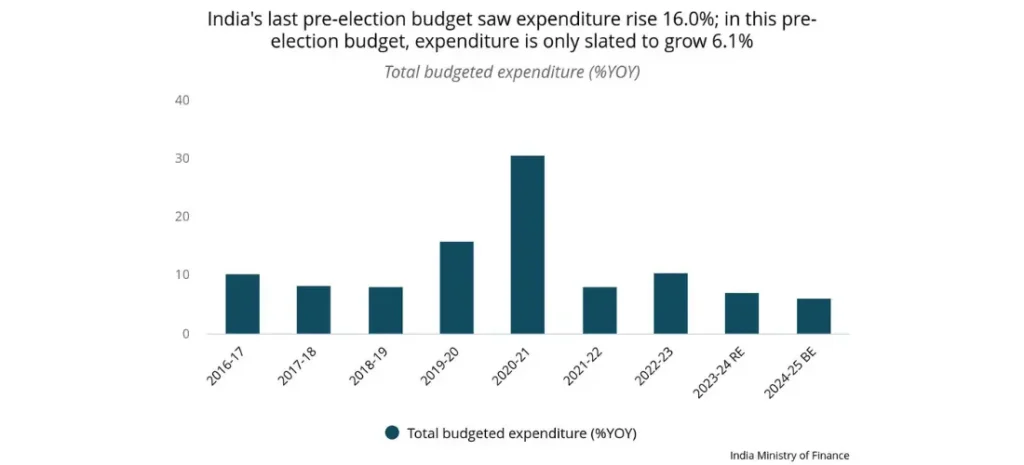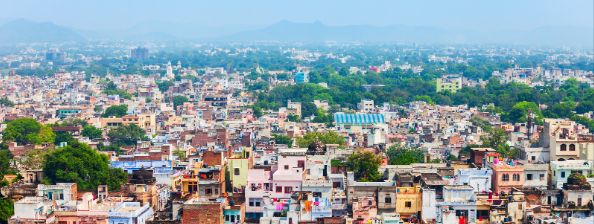
The conservative budget suggests Modi is confident in the run-up to the polls
Companies should utilize India’s interim budget to inform their plans for the rest of this year. The Bharatiya Janata Party (BJP) is likely to win upcoming elections, so the interim budget and the final budget are likely to be very well aligned.
B2B companies who serve customers in semiconductors, displays, electronics, automobiles and components, pharmaceuticals, and food processing should prepare for a potential uptick in demand as India’s incentive programs receive more funding and see more uptake. Executives should consider speaking to their customers proactively to get ahead of any major investment decisions. B2B companies should also expect less investment to flow into transport infrastructure in the coming quarters (though there will still be ample opportunity in the field as projects from past years continue into FY 2024–2025).
Consumer companies should expect relatively little change in the market due to the new budget. The Modi administration has been extraordinarily reserved in its allocations this year, as the BJP seems assured of winning upcoming elections. Executives who developed targets on the assumption that populist, pre-election spending would boost their prospects this year should actively revise their projections.
Healthcare companies should continue to prioritize business development in the private sector over the public sector where possible. Given the limited public funding flowing to healthcare and the government’s struggles with budget execution, executives are likely to see success by aligning their product portfolio with the needs of private hospital chains and focusing their marketing and sales efforts on that customer segment. (For more details, see our analysis here.)
Overview
- In early February, India’s government released its interim budget for FY 2024–2025. (The final budget will be released after elections.) Relative to past years, leaders showed a remarkable amount of fiscal restraint, particularly considering upcoming elections.
- In the budget, total expenditure is projected to rise approximately 6.1% relative to the revised estimate for FY 2023–2024. This rate of increase would be the lowest seen in recent years and dramatically lower than the 16.0% rise seen in the last pre-election budget.
- India’s government did not introduce major new spending or tax measures in its interim budget. Instead, it focused on making incremental changes to current programs and drawing down the country’s fiscal deficit toward the more sustainable levels seen before the pandemic.
Our View
The government’s willingness to pursue fiscal consolidation in a pre-election budget speaks to the confidence of the BJP going into this year’s elections. This confidence is largely justified. We expect Prime Minister Modi and the BJP to win upcoming elections and maintain control over the government. Thus, while leaders may adjust some details when the final FY 2024–2025 budget is released after elections, any changes are likely to be minor.
Selected takeaways:
- Transport spending: While transportation remains a priority for the government (it has grown to be larger than any other spending category save interest payments over the last several years), leaders have shown much less enthusiasm for the category in this budget than in past years. They plan to increase transport spending by only 3.6% in FY 2024–2025, down from 41.3%, 53.2%, 17.5%, and 34.4% in the last four fiscal years.
- Subsidies: The budget’s allocations for fertilizer, food, and petrol subsidies are set to shrink by -13.2%, -3.3%, and -2.6%, respectively, suggesting that leaders intend to rein them in after several years of outsized spending due to the pandemic and heightened inflation. Even so, the recent extension of the PMGKAY food ration scheme demonstrates leaders’ continued commitment to large-scale subsidy programs. If inflation reignites this year, so will subsidy spending.
- Healthcare spending: On the surface, health appears to be a priority for leaders. The government budgeted a 13% increase in spending on the category relative to revised estimates for FY 2023–2024. However, this increase is largely due to poor budget execution, particularly in the field of capital expenditures. (If compared to the original FY 2023–2024 budget estimate, health spending in this budget saw a minor increase.) Overall, health expenditure as a portion of the total budget remains well below pre-pandemic levels.
- Investment incentives: India’s government remains actively committed to boosting investment through incentives. Spending in this area (including production-linked incentives and programs to promote semiconductor and electric vehicle manufacturing) is primed to rise over 65% in FY 2024–2025. While the programs cover a range of industries, the lion’s share of the incentives are earmarked for semiconductors, displays, electronics, automobiles and components, pharmaceuticals, and food processing.
At FrontierView, our mission is to help our clients grow and win in their most important markets. We are excited to share that FiscalNote, a leading technology provider of global policy and market intelligence has acquired FrontierView. We will continue to cover issues and topics driving growth in your business, while fully leveraging FiscalNote’s portfolio within the global risk, ESG, and geopolitical advisory product suite.
Subscribe to our weekly newsletter The Lens published by our Global Economics and Scenarios team which highlights high-impact developments and trends for business professionals. For full access to our offerings, start your free trial today and download our complimentary mobile app, available on iOS and Android.

